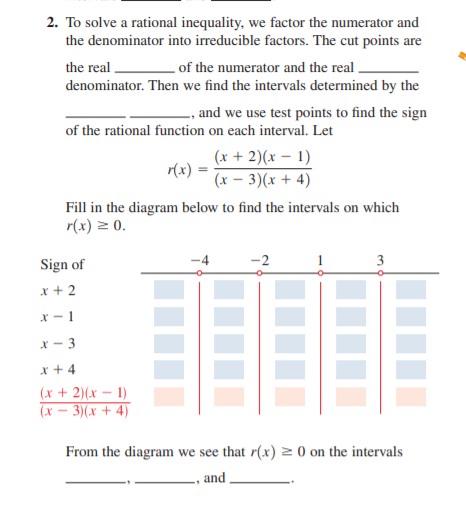2. To solve a rational inequality, we factor the numerator and the denominator into irreducible factors. The cut points are the real of the numerator and the real. denominator. Then we find the intervals determined by the -, and we use test points to find the sign of the rational function on each interval. Let (x + 2)(x – 1) r(x) = (x – 3)(x + 4) Fill in the diagram below to find the intervals on which r(x) 2 0. 3 Sign of x + 2 x - 1 x - 3 x + 4 (x + 2)(x – 1) (x – 3)(x + 4) From the diagram we see that r(x) 2 0 on the intervals , and
2. To solve a rational inequality, we factor the numerator and the denominator into irreducible factors. The cut points are the real of the numerator and the real. denominator. Then we find the intervals determined by the -, and we use test points to find the sign of the rational function on each interval. Let (x + 2)(x – 1) r(x) = (x – 3)(x + 4) Fill in the diagram below to find the intervals on which r(x) 2 0. 3 Sign of x + 2 x - 1 x - 3 x + 4 (x + 2)(x – 1) (x – 3)(x + 4) From the diagram we see that r(x) 2 0 on the intervals , and
College Algebra
7th Edition
ISBN:9781305115545
Author:James Stewart, Lothar Redlin, Saleem Watson
Publisher:James Stewart, Lothar Redlin, Saleem Watson
Chapter3: Polynomial And Rational Functions
Section3.7: Polynomial And Rational Inequalities
Problem 2E
Related questions
Question
To solve a rational inequality, we factor the numerator and
the denominator into irreducible factors. The cut points are
the real of the numerator and the real
denominator. Then we find the intervals determined by the
, and we use test points to find the sign
of the rational function on each interval. Let

Transcribed Image Text:2. To solve a rational inequality, we factor the numerator and
the denominator into irreducible factors. The cut points are
the real
of the numerator and the real.
denominator. Then we find the intervals determined by the
-, and we use test points to find the sign
of the rational function on each interval. Let
(x + 2)(x – 1)
r(x) =
(x – 3)(x + 4)
Fill in the diagram below to find the intervals on which
r(x) 2 0.
3
Sign of
x + 2
x - 1
x - 3
x + 4
(x + 2)(x – 1)
(x – 3)(x + 4)
From the diagram we see that r(x) 2 0 on the intervals
, and
Expert Solution
This question has been solved!
Explore an expertly crafted, step-by-step solution for a thorough understanding of key concepts.
This is a popular solution!
Trending now
This is a popular solution!
Step by step
Solved in 3 steps

Knowledge Booster
Learn more about
Need a deep-dive on the concept behind this application? Look no further. Learn more about this topic, algebra and related others by exploring similar questions and additional content below.Recommended textbooks for you

College Algebra
Algebra
ISBN:
9781305115545
Author:
James Stewart, Lothar Redlin, Saleem Watson
Publisher:
Cengage Learning


Algebra & Trigonometry with Analytic Geometry
Algebra
ISBN:
9781133382119
Author:
Swokowski
Publisher:
Cengage

College Algebra
Algebra
ISBN:
9781305115545
Author:
James Stewart, Lothar Redlin, Saleem Watson
Publisher:
Cengage Learning


Algebra & Trigonometry with Analytic Geometry
Algebra
ISBN:
9781133382119
Author:
Swokowski
Publisher:
Cengage

College Algebra (MindTap Course List)
Algebra
ISBN:
9781305652231
Author:
R. David Gustafson, Jeff Hughes
Publisher:
Cengage Learning

Algebra for College Students
Algebra
ISBN:
9781285195780
Author:
Jerome E. Kaufmann, Karen L. Schwitters
Publisher:
Cengage Learning
